About 20% of health care workers have quit during this period, he said, and 4 out of 5 of those who remain say that staff shortages have affected their ability to work safely and to satisfy patient needs…
— from “U.S. Faces Crisis of Burned-Out Health Care Workers” in U.S. News and World Report, November 2021
At a recent meeting of Archuleta County’s ‘Health Department Transitional Advisory Committee’, a committee member, Pagosa Springs Medical Center CEO Dr. Rhonda Webb, made a statement that the nation’s health care sector had lost 20% of its workers during the COVID crisis.
I found the claim curious, and surprising. 20%? I’d not come across a similar claim in the news outlets that I follow. Maybe I was following the wrong sources…
Archuleta County’s ‘Health Department Transitional Advisory Committee’ is charged with developing a plan for standing up a new County Public Health Department, and certainly a huge exodus of workers from the health care industry would be a concern, if it were actually taking place. For 70 years, Archuleta County has been served by the San Juan Basin Public Health district, but the two counties served by that district — La Plata and Archuleta — saw their Board of County Commissioners vote to dissolve the district, and for each county to stand up its own independent public health department by January 1, 2024.
But is our nation’s health care sector really facing a massive shortage of health care professionals?
Or did I, perhaps, misunderstand Dr. Webb’s comment?
A bit of research brought up several news articles from 2021, documenting a significant drop in health care employment.
But that’s not the end of the story. It’s a bit more complicated, and nuanced.
According to a fascinating January 2023 article on the ‘Health System Tracker’ website — a collaborative effort funded in part by the Kaiser Family Foundation — America’s health industry employment doubled between 1990 and 2020, from about 800,000 workers to about 1.6 million.
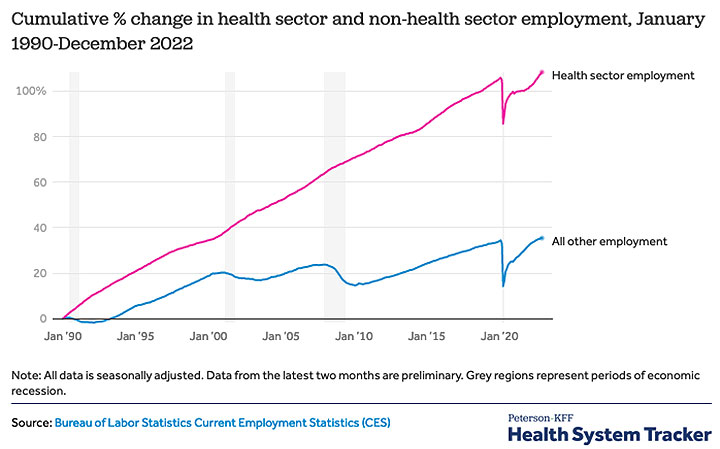
As we see, above, even during the 2000-2001 recession, and the Great Recession from 2008-2009, employment in the health care industry continued to increase, while other industries saw significant job losses that lingered for several years. The COVID crisis saw a different result in 2020, with dramatic job losses in all industries, including the health sector.
By December 2022, however, most industry sectors had recovered to 2019 levels. But not all.
Below is a graph for health sector employment, from 2020 through the end of 2022. As we can see, job growth — or lack thereof — has been very different in different sub-sectors.
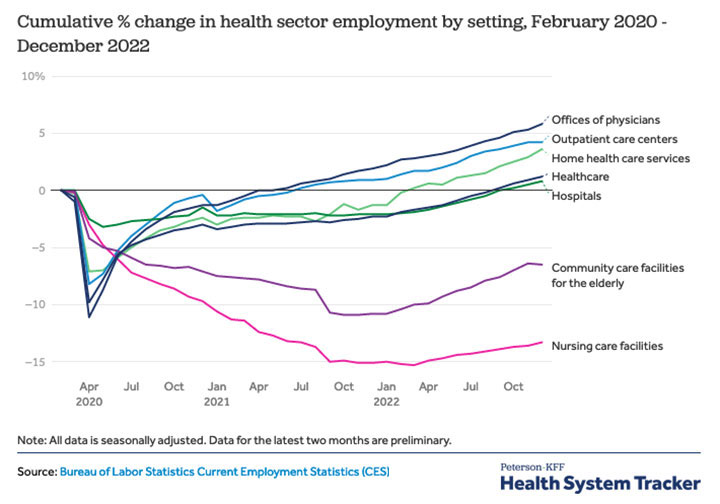
Employment in nursing care facilities fell off slowly… but then has remained comparatively low, down about 13% since the start of the COVID crisis.
Hospital employment, meanwhile, dropped relatively little during the crisis, and is now at about 1% above February 2020.
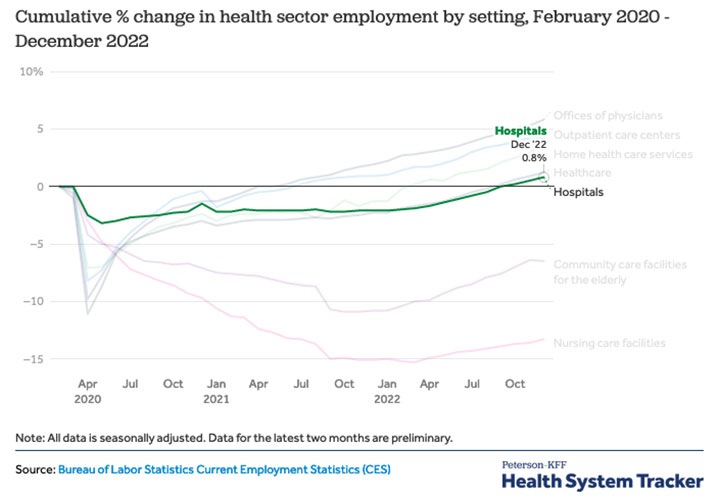
Employment in the health care industry as a whole is up about 1% from February 2020, but still below where it was previously projected to be, based on the growth patterns prior to 2020.
Here’s the curve for the health care sector as a whole, as calculated by Health System Tracker.
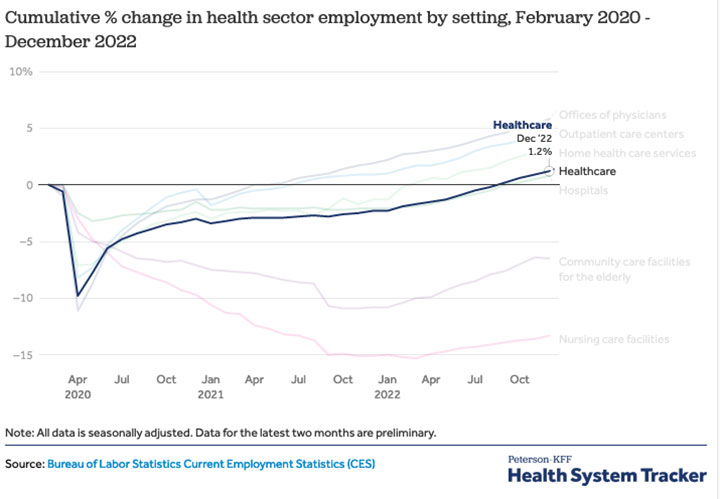
And here’s the curve for ‘Nursing care facilities’. As we can see, the current crisis seems to be in nursing care.
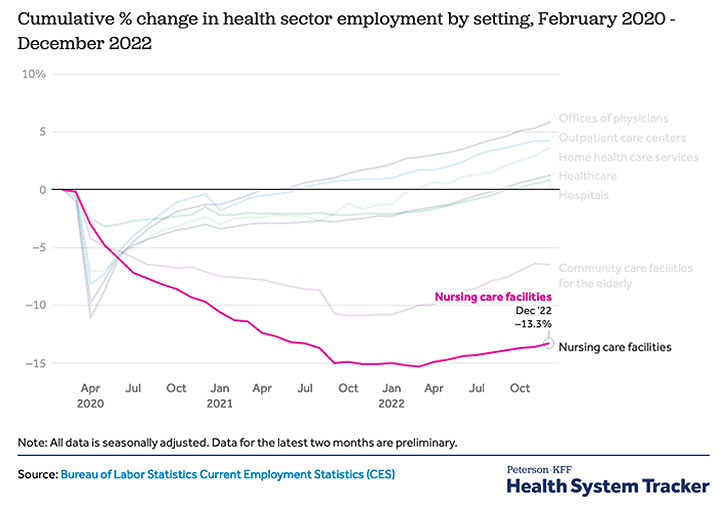
Here in Archuleta County, about 30% of the population declined to get ‘fully vaccinated’ during the COVID crisis, and this number might indicate a more general dissatisfaction, among those particular folks, with the health care sector as a whole.
The vaccination rate was slightly higher in La Plata County. Meanwhile, the overall political support from elected leaders for conventional COVID strategies — mask mandates, school closures, vaccinations — was somewhat different in the two counties, with La Plata County leadership generally embracing the strategies coming from San Juan Basin Public Health, and the Archuleta BOCC raising questions about certain policies.
This week, the La Plata County BOCC and the Archuleta County BOCC reaffirmed their commitment to the dissolution of San Juan Basin Public Health, at separate meetings on March 28.
In Archuleta County, at a BOCC work session that morning, County Manager Derek Woodman noted that certain members of the Health Department Transitional Advisory Committee were encouraging Archuleta County to make an attempt to reverse the dissolution process.
Woodman noted that he and the commissioners had contacted La Plata County representatives, and learned that La Plata County does not support a reconciliation.
Pagosa Springs Medical Center Clinic Medical Director Dr. Julie Buchner and PSMC Chief of Staff Dr. John Wisneski had sent letters to the commissioners in both counties, asking them to consider reconciliation, due to potential negative health impacts to both communities.
The La Plata BOCC, also on March 28, approved a response to Drs. Buchner and Wisneski, stating in part, “It seems premature to conclude that the dissolution of the health district will have a negative impact on services in both counties. While we do anticipate facing some challenges during the transition, we are confident that both Archuleta and La Plata counties will ultimately benefit from this transformation. We hope you will support our ongoing efforts…”
Both counties have budgeted money for start-up costs. The physical assets of San Juan Basin Public Health — real estate, vehicles, office equipment and so on — will be divided between the two counties.
The key challenge, I presume, will be to find the employees, and to find homes for the employees to live in.
Is that part of the conversation?
